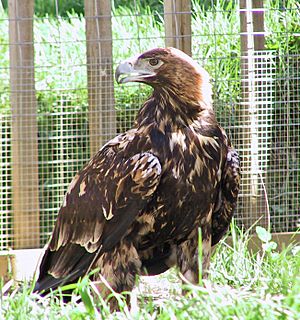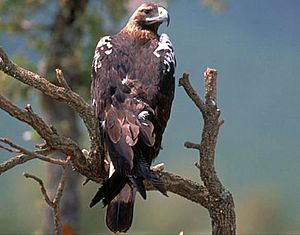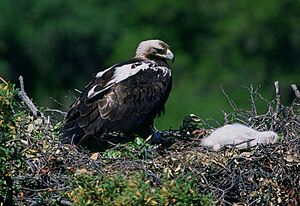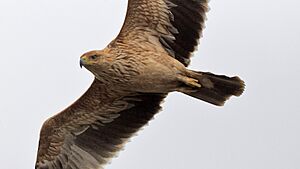Spanish imperial eagle facts for kids
Quick facts for kids Spanish imperial eagle |
|
|---|---|
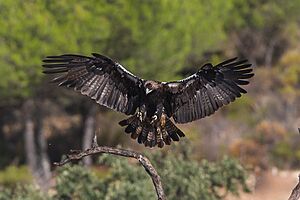 |
|
| A Spanish imperial eagle flying down to its perch | |
| Conservation status | |
| Scientific classification | |
| Genus: |
Aquila
|
| Species: |
adalberti
|
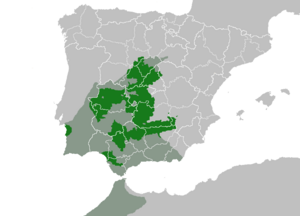 |
|
| Synonyms | |
|
Aquila heliaca adalberti |
|
The Spanish imperial eagle (Aquila adalberti) is a large bird of prey. It is also known as the Iberian imperial eagle or Adalbert's eagle. This eagle lives mainly in the Iberian Peninsula, which includes Spain and Portugal. Its scientific name honors Prince Adalbert of Bavaria. People sometimes called it the "white-shouldered eagle" because of its unique white patches.
This eagle was once thought to be a type of eastern imperial eagle. However, scientists now know it is a separate species. They found differences in its body shape, how it lives, and its genetic makeup.
Contents
What Does the Spanish Imperial Eagle Look Like?
The Spanish imperial eagle is a very large bird of prey. It is similar in size to its cousin, the eastern imperial eagle. It is a bit smaller than the golden eagle but larger than the Bonelli's eagle. These eagles can weigh from 2.5 to 4.8 kilograms (5.5 to 10.6 pounds).
Males usually weigh about 3.19 kg (7 lb). Females are a bit heavier, averaging 3.43 kg (7.6 lb). The Spanish imperial eagle is about 72 to 85 centimeters (28 to 33 inches) long. Its wings can spread from 177 to 220 centimeters (5.8 to 7.2 feet) wide.
Adult and Young Eagles
Adult Spanish imperial eagles are a dark blackish-brown color. This dark color covers their throat all the way down to their belly. They have a clear white band on their shoulders and the front edge of their wings. This white band is even more noticeable than on the eastern imperial eagle. Their neck and head are a lighter, tawny (yellowish-brown) color.
Young Spanish imperial eagles look very different from adults. They are a pale, sandy color all over. They have wide black bands on both the top and bottom of their wings. When flying, they hold their wings flatter than a golden eagle.
Where Do Spanish Imperial Eagles Live?
These eagles live in central and southwest Spain and nearby parts of Portugal. They are most common in the dehesa woodlands. These woodlands are found in areas like Extremadura and Ciudad Real in Spain.
Unlike some other eagles, the Spanish imperial eagle does not migrate. It stays in the same area all year round. Young eagles sometimes visit Morocco during their travels. Sadly, many young eagles are harmed by power lines in Morocco. This is because the power lines are not safely built there yet. Some eagles have even flown as far as Mauritania and Senegal. Very rarely, one has been seen as far north as the Netherlands.
How Do Spanish Imperial Eagles Live?
Reproduction and Life Cycle
Spanish imperial eagles like to build their nests in dry, old woodlands. They choose places that are quiet and away from people. Their nests are often close to open areas and wetlands. These areas have more prey for them to hunt.
These eagles are very shy around humans. They usually nest only where there is little human activity. Like most birds of prey, they protect their home area. Spanish imperial eagles build their nests from February to April. They make large nests, up to 1.5 meters (5 feet) wide. They often build them in cork oaks or pine trees.
A female eagle usually lays two or three eggs. The eggs hatch after about 43 days. On average, about 1 to 2 young eagles survive per nest. Sometimes, young eagles die because of human disturbance or if the nest falls. Other times, older siblings might harm younger ones. Young eagles can fly when they are about 63 to 77 days old. They stay with their parents for a long time, sometimes up to 160 days after learning to fly.
What Do Spanish Imperial Eagles Eat?
The main food for the Spanish imperial eagle is the European rabbit. Rabbits used to make up about 58% of their diet. However, diseases like myxomatosis and rabbit haemorrhagic disease have greatly reduced rabbit numbers.
Because of this, these eagles now eat many other animals. They hunt water birds like Eurasian coots, ducks, and geese. They also eat partridges, pigeons, and crows. More than 60 different bird species are known to be part of their diet. They also hunt mammals like rodents, hares, mustelids (like weasels), and hedgehogs. Sometimes, they even catch larger animals like red foxes. Very rarely, they might eat reptiles or fish.
The largest prey they catch can weigh over 3.3 kg (7.3 lb). This includes foxes or large birds like greylag geese or white storks. However, the average size of their prey is usually smaller.
Spanish imperial eagles are top predators in their habitat. They usually do not have natural enemies. However, they sometimes fight with other birds of prey over food. They have even been known to kill other large birds, like a cinereous vulture, to protect their nest. When protected from human dangers, adult eagles can live long lives.
How Are Spanish Imperial Eagles Protected?
The Spanish imperial eagle is listed as a Vulnerable species. This means it is at risk of becoming endangered. The biggest threats to these eagles are:
- Loss of habitat: Their natural homes are being destroyed.
- Human activity: People disturbing their nesting areas.
- Power lines: Collisions with electric pylons cause many deaths. In the 1980s, power lines caused 80% of deaths for young eagles.
- Poisoning: Illegal poisoning is also a problem.
- Lack of food: The decline in rabbit populations means less food for the eagles.
In the 1960s, there were only about 30 pairs of these eagles left, all in Spain. They were critically endangered. Thanks to conservation efforts, their numbers started to grow in the 1980s. By 2011, the global population had grown to 324 pairs. Most of these, 318 pairs, were in Spain.
The eagles returned to Portugal in 2003 after being absent for over 20 years. Their numbers there are slowly increasing. This success is due to many things. These include making power lines safer, providing extra food, fixing nests, and reintroducing eagles to new areas. Also, people are disturbing the breeding birds less.
Images for kids



